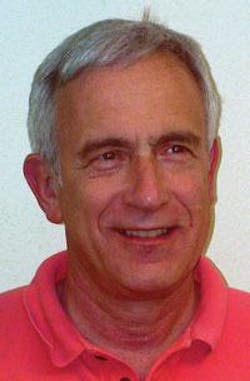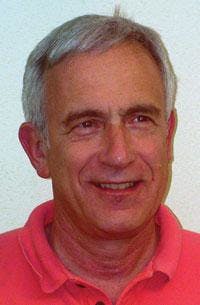Michael S. Feld
By Barbara Goode
Professor Michael S. Feld, who directs both the George R. Harrison Spectroscopy Laboratory and the Laser Biomedical Research Center at MIT, has received numerous awards. His most recent is the Optical Society of America’s 2008 Meggers Award “for major contributions to the foundations of laser spectroscopy, and for pioneering developments in the application of spectroscopy to biomedicine.” But the accolades he’s received extend beyond such significant scientific achievements.
Feld was born in New York and “bred” at the Massachusetts Institute of Technology, where he earned all of his degrees and went on to become a professor of physics. Educated as a physical scientist, he focused his Ph.D. research on laser spectroscopy, studying the fundamental interactions of light with matter. In 1973, he made the first experimental observation of superradiance, the collective spontaneous emission of an assembly of excited atoms, which he describes as “a very exciting fundamental advance.”
He seeks to solve problems by understanding the basics rather than by adopting an empirical approach. In the mid-1980s he began to shift his research to an applied field—biomedical optics, in which much of his work involves physical models of light interacting with biological molecules and tissues. His style is to extract information from such models instead of using statistical methods. “Approaching problems in this way has been successful for me, and it goes against the standard approach of biomedical research,” Feld says. “This gives me an ‘unfair advantage’ over the competition.” Now his former students and their students, as well as others, are adopting this style. “I find that gratifying,” he says.
Raman spectroscopy
In 1991, Feld pioneered the use of Raman spectroscopy for analysis of biological tissue. This led to its clinical use, in 2006, in diagnosing atherosclerosis and breast cancer. In 1998, his group introduced the use of light-scattering spectroscopy for characterizing precancerous change and, in 2001, the combined use of fluorescence and reflectance spectroscopy for spectral diagnosis of disease. Implementing these techniques clinically required significant development of novel instruments and spectral probes.
Raman spectroscopy has been used widely in industry for decades, but its use in biomedical tissue spectroscopy was limited. “Multiple difficulties had to be overcome,” says Feld. “First, Raman signals were thought to be too weak to be observed at the excitation levels safely used to irradiate biological tissue, and collection times were unacceptably long for clinical use.” In Feld’s first experiments with tissue samples it took 30 minutes to collect the Raman spectra, which were overwhelmed by background fluorescence. But looking closely at that data, Feld was able to recognize clearly defined signals. He was encouraged enough by these results to persevere, even when an evaluation committee of Raman experts advised him to terminate the project. “A further concern raised by the committee,” recalls Feld, “was that was that even if the Raman signals could be discerned, you’d see nothing but ‘Raman grass,’ weak Raman signals due to the overlap of spectra from numerous molecules in the tissue.” Feld managed to convince the committee to let him proceed, and it’s a good thing: this work has laid the foundation for the field of Raman spectral diagnosis of disease, and encouraged development of coherent anti-Stokes Raman spectroscopy (CARS) and surface-enhanced Raman spectroscopy (SERS), as well.
As Feld’s Raman research progressed, he and his colleagues recognized that data could be collected much more rapidly with CCD rather than the then-standard Fourier-transform technology. “We realized that CCD detection could enable data to be collected at the shot noise level,” he says. “Understanding this was the key.” Combined with other advances, this allowed Feld and his team to reduce data collection time from 30 minutes to one second or less, acceptable for use in clinical situations. Finally, to make the technique clinically useful, a unique type of Raman spectral probe had to be developed to overcome the large quartz Raman background from three meters of optical fiber.
“The fun of this,” he says, “is that we took nothing and made it into something—something that is useful and makes sense.”
Fundamental science
His major influences include his Ph.D. thesis advisor, Ali Javan, inventor of the helium-neon laser, the first gas laser—with whom he worked in the area of fundamental physics. Another influence was Charles Townes, head of the laser group at MIT, who won the Nobel prize for inventing the maser, the precursor of the laser concept (which Townes called the “optical maser,” and the inspiring Japanese physicist, Koichi Shimoda, with whom Feld worked at MIT in his first year as a grad student.
“All of my role models were in the area of fundamental physical science, not biomedical science—and that has given me a different perspective,” says Feld. “It has sometimes put me at odds with the conventional wisdom of biomedical science.”
But even earlier, Feld had found an important mentor in his Uncle George, an electrical engineer who worked in the field of radio and television. “He always talked to me about technical things and, using his textbooks from City College of New York, introduced me to math concepts years before I learned them in school,” says Feld. “That made a huge difference for me, as my father had died at a young age.”
It is clear from talking with Feld that he is effectively “paying forward” his uncle’s gift of encouragement. One way he does this is in acting on his deeply held beliefs about encouraging underrepresented minorities in science. He has graduated five African American Ph.D.s, the first of whom was Ron McNair, who went on to become the first black astronaut scientist and, sadly, died in the 1986 Challenger accident.
“My goals in this area are generally modest,” says Feld. I know I can’t change the world, but I feel I can effectively change my own institution.” He has chaired and cochaired several efforts including MIT’s Martin Luther King committee. This group developed the Martin Luther King Visiting Professor program, in which up to a dozen minority professors each year come to MIT for one- to two-year visits. More than 60 MLK visiting professors have come to MIT through this program. Feld views this as a temporary measure to fill the current void of the presence of underrepresented minority faculty members at MIT. These MLK visiting professors have no obligation to work on minority issues when they come; rather they engage in scholarship and teaching, as do all other MIT professors, and thus serve an important function as role models—for both the minority and majority students.
“This committee, and the earlier Equal Opportunity Committee, which I also chaired, has played an activist role,” says Feld. “Each of the four MIT presidents with whom I’ve worked has warmly welcomed my initiatives in this area.” Feld has won three MIT awards for his activist role, including the 2008 Martin Luther King Jr. Achievement Award, given by the MIT Campus Committee on Race and Diversity to honor his “extensive and persistent efforts to make MIT a more open, more welcoming, and more harmonious workplace.”
For all of Feld’s incredible scientific and social accomplishments, the effort that got him the most attention was his lecture-demonstrations on the physics of karate. Ron McNair had introduced him to karate and invited him and his 8-year-old twin sons to join a karate club McNair had started at his church near MIT. As Feld recalls, “Then someone at MIT called to invite me to give a Christmas lecture on the physics of karate. ‘Sure,’ I said. As soon as I got off the phone I was gripped with terror—I realized that I had just agreed to give a lecture on a topic I knew nothing about! Motivated by fear, I began a crash research program, including taking strobe movies of karate strikes. Fortunately, we managed to get our act together and did well, and so we were invited to give presentations at two annual meetings of the American Association for the Advancement of Science, the first in Washington, DC, and the second the following year in Denver. In the course of our research we wrote a 1979 Scientific American article, ‘The Physics of Karate,’ which attracted worldwide press interest.”
Feld says that people often ask him what technological developments are holding back advancement of the field of biomedical optics. “This question misses the point,” he says. “The field doesn’t advance more rapidly because of people’s thinking. Basic understanding is the great limiter. A case in point: today, one of the most important problems in biological tissue imaging is our inability to see deeply into tissue. People have been misled by diffusion theory, which wrongly predicts that light cannot propagate through turbid tissue. In fact, light propagation through tissue should be viewed as a wave phenomenon rather than a succession of bullets. Photons have nothing to do with it.” Feld believes that E-field-based wave techniques can overcome the current limitations. “Optical CT may be possible!” he says.

